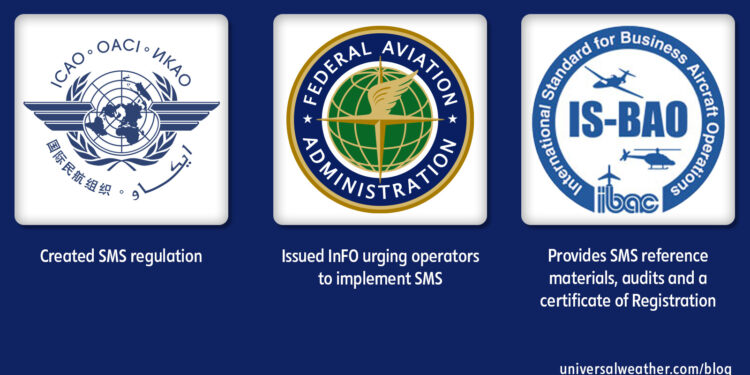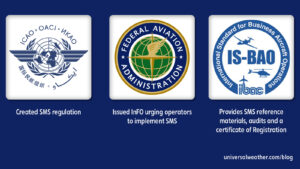Understanding SMS Programs for Business Aviation

This aviation blog post is part of a series on safety management systems for business aviation.
A Safety Management System (SMS) can be a tricky area and hot topic for many business aviation operators who want to implement a program like it. These operators may have misconceptions about what an SMS actually is, what it means and what it’s supposed to do. While enforcement of this International Civil Aviation Organization (ICAO) requirement has been somewhat sporadic and lax to date, there have been operators who’ve been denied landing permits due to the lack of a verifiable SMS.
Eventually, SMS requirements will impact all business operators – both charter (non-scheduled commercial) and private non-revenue – so now is the time to understand the process and consider SMS compliance options. To preserve freedom of international movement of your corporate aircraft, talk with your 3rd-party provider about potential SMS-related operating or permit challenges you may face today and for guidance on resources to move toward SMS compliance.
1. Defining SMS.
An SMS for private non-revenue and charter (non-scheduled commercial) operators involves identifying potential hazards and documenting a plan to effectively manage them. Additionally, this program ensures that the efforts put forth meet the intended safety objectives (safety assurance). We all want to operate as professionally and safely as possible. A well thought-out written plan helps us achieve this on an ongoing basis. Beyond the goal of safety, there are many practical considerations for developing an SMS. Benefits include unhindered and more flexible access within ICAO airspace (as enforcement of SMS becomes increasingly widespread). Operators have reported reduced insurance premiums after completing International Standard for Business Aircraft Operations (IS-BAO) registration, one of the ways currently available to show evidence of SMS compliance.
2. Understanding SMS.
The main idea of an SMS is to integrate control of risk into normal day-to-day business practices. Safety is managed as a “core business function,” where the organization treats safety in the same way it manages other functions. The components of an SMS are policy, safety risk management, safety assurance and safety promotion. ICAO standards state that General Aviation (GA) operators must establish and maintain an SMS “appropriate to the size and complexity of the operation.” In practice, it may take operators three years to fully develop and implement an SMS. This program applies to your entire fleet and does not necessarily have to be updated with change of aircraft.

3. Deciphering if SMS applies to your operation.
ICAO issued an SMS standard in 2006. This standard applies to all operations of aircraft by operators authorized to conduct international commercial air transport (Annex 6, Part 1) and to private aircraft with a certified Maximum Takeoff Weight (MTOW) of 12,500 pounds (5,700 kg) and/or private aircraft with one or more turbo jet engines (Annex 6, Part 2, Chapter 3). ICAO mandates that member states require, as part of a state safety program, operators to establish an SMS for commercial operations. For GA, an operator conducting international operations over 12,500 pounds (5,700 kg MTOW) is required to establish an SMS (Annex 6, Part 2).
4. Considering charter (non-revenue) vs. private non-revenue SMS requirements.
Part 1 of ICAO’s SMS mandate deals with scheduled commercial transport and charter (non-scheduled commercial) operations, while Part 2 deals with private non-revenue aircraft. The process can be unclear to operators trying to implement this program. Under Part I, ICAO puts the onus on the state to regulate and approve SMSs. However, under Part 2, the onus is on the operator to implement and maintain the SMS. The problem for charter operators is that the Federal Aviation Administration (FAA) does not approve SMS programs. In the future, private operators may be required to verify their SMSs when applying for permits. If the aircraft is ramp-checked, and you’re not able to provide evidence of an SMS, you may be determined non-compliant, so we find it best practice to have a program set in place.
5. Knowing practical implications of SMS.
The FAA has not yet implemented ICAO SMS standards. However, it recently issued official Information for Operators (InFO) 11010, urging GA business and corporate operators to implement an SMS. In the InFO, the FAA said the agency had no immediate plans to require SMSs for non-commercial operators. However, it reminded pilots that, when operating in a foreign country, the rules of that nation must be followed. Canada has been proactive in implementing an SMS requirement guidance for its operators but still does not yet require U.S. operators to show proof of SMS compliance. While the European Union and other ICAO regions technically require SMS for non-commercial operators flying within their airspace, enforcement has been rare to this point
Questions?
If you have any questions about this article, contact me at christinevamvakas@univ-wea.com.
Later, we’ll discuss SMS implementation and related considerations for business aviation operators.




